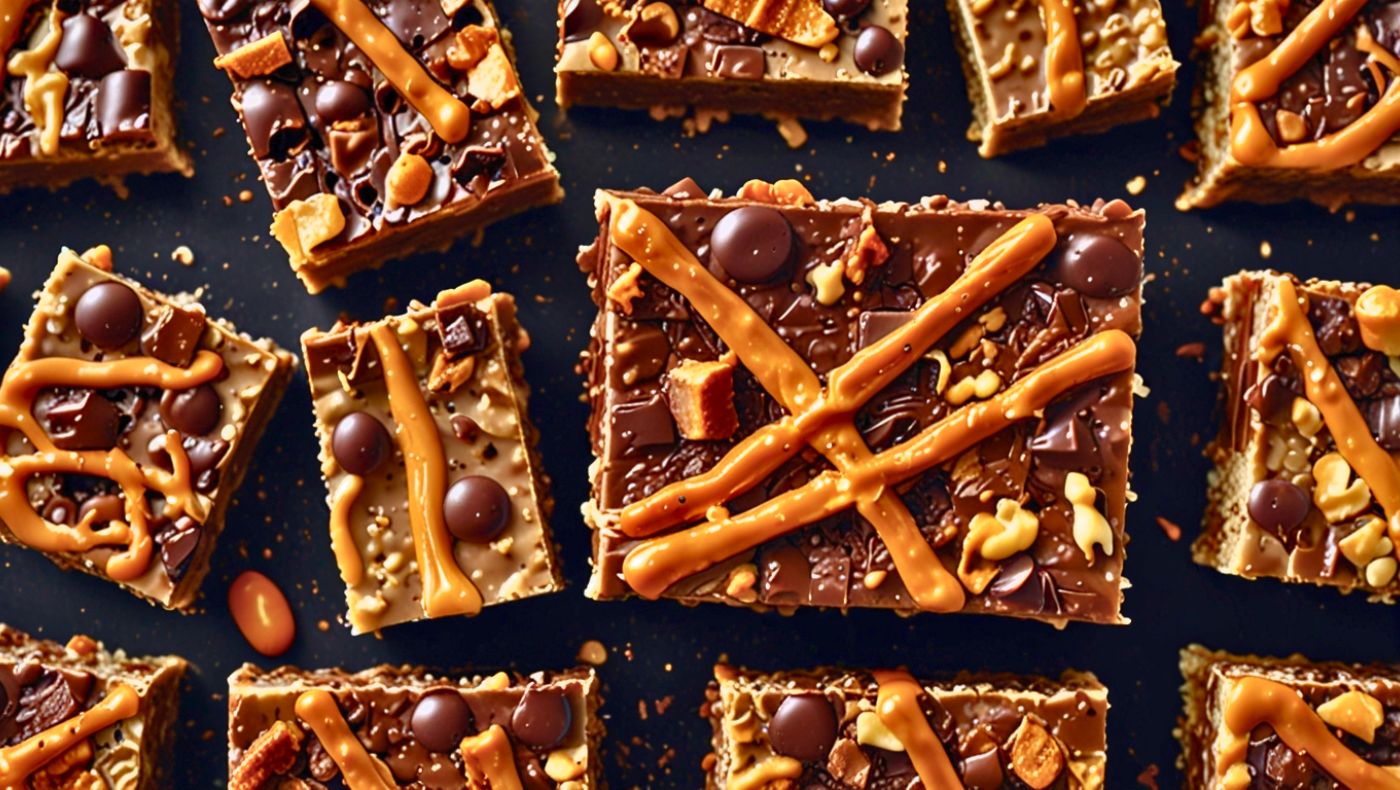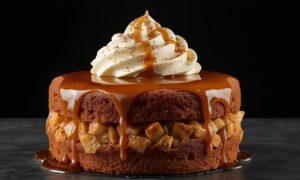Craving that perfect mix of sweet, salty, and crunchy? You’re in for a treat with Salted Chocolate and Caramel Pretzel Bars. I first made them on a rainy afternoon, simple ingredients, quick steps, and the result? Pure bliss. That first bite sealed the deal, crisp pretzels, buttery caramel, and rich chocolate in perfect harmony..
Can a no bake dessert really taste this good? Yes, it can, and these bars prove it. They’re dangerously addictive, easy to share (if you want to), and gone in minutes. Perfect for parties, gifts, or just a cozy night in.
In this post, I’ll walk you through how to make Salted Chocolate and Caramel Pretzel Bars from start to finish. No fancy tools. No stress. Just a few simple steps to dessert perfection.
You’ll learn how to layer flavors, melt ingredients just right, and get that perfect sweet salty crunch every time. These Salted Chocolate and Caramel Pretzel Bars aren’t just easy, they’re unforgettable.
What Makes These Bars Special
These bars master the sweet salty game perfectly. Most desserts stick to one flavor profile. These bars blend multiple elements into pure harmony. The buttery base anchors everything. Rich caramel adds depth. Chocolate brings luxury.
The caramel layer delivers more than sweetness, it brings complexity. Proper caramelization creates butterscotch notes and subtle bitterness. This chewy texture contrasts beautifully with crisp pretzel pieces. The chocolate layer adds richness while sea salt crystals burst with flavor.
Professional chefs love these bars because they showcase key techniques. Shortbread construction, caramel mastery, and ganache prep all in one recipe. Each layer teaches essential skills while creating something greater than its parts.
Ingredients & Substitutions
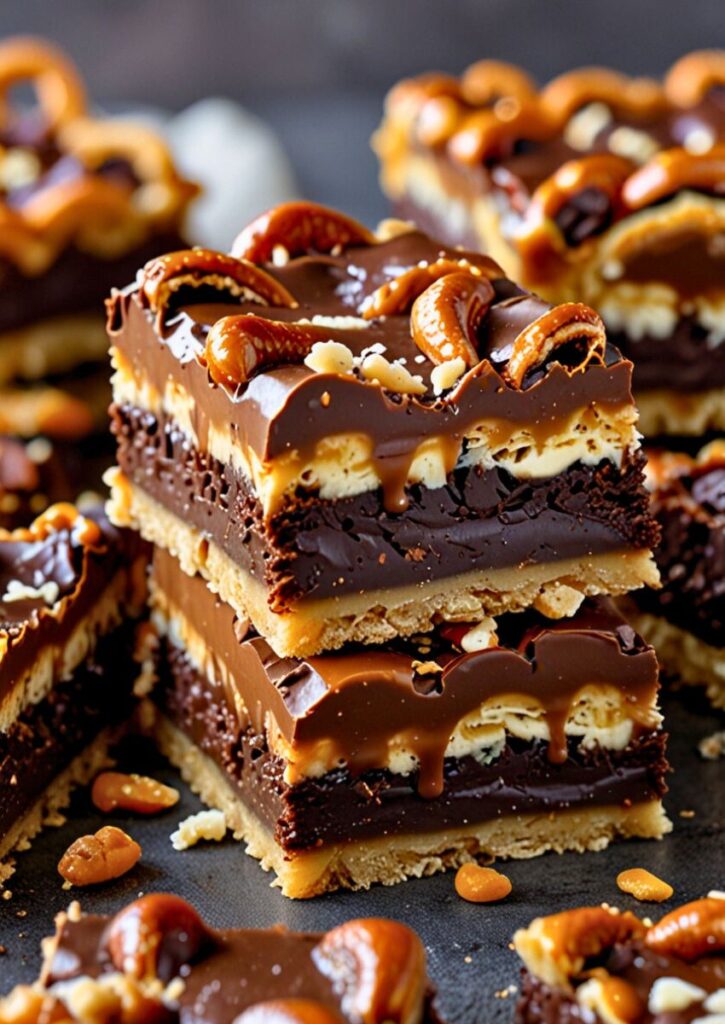
For the Shortbread Base:
- 2 cups all purpose flour (240g)
- 1/2 cup powdered sugar (60g)
- 1/2 teaspoon fine sea salt
- 1 cup cold unsalted butter, cubed (226g)
- 1 large egg yolk
- 2 tablespoons heavy cream
For the Caramel Layer:
- 1 cup granulated sugar (200g)
- 6 tablespoons unsalted butter (85g)
- 1/2 cup heavy cream, warmed
- 1 teaspoon vanilla extract
- 1/2 teaspoon sea salt
- 2 cups mini pretzels, roughly chopped
For the Chocolate Ganache:
- 8 oz dark chocolate (60-70% cacao), chopped
- 3/4 cup heavy cream
- 2 tablespoons unsalted butter
- Flaky sea salt for finishing
Professional Tips:
European butter works best for shortbread. Higher fat content, less water. Creates superior texture. American butter works too, just use slightly less liquid. For gluten free versions, try 1:1 baking flour. Texture will be more delicate.
Sugar choice impacts caramel behavior dramatically. Granulated sugar caramelizes predictably. Brown sugar adds molasses notes but can seize unexpectedly. Coconut sugar works for refined sugar free versions but needs temperature adjustments.
Chocolate quality matters here. Single origin chocolates with 65-70% cacao hit the sweet spot. Enough bitterness to cut sweetness without overwhelming caramel. Valrhona, Callebaut, or Guittard deliver consistent results.
Step by Step Instructions
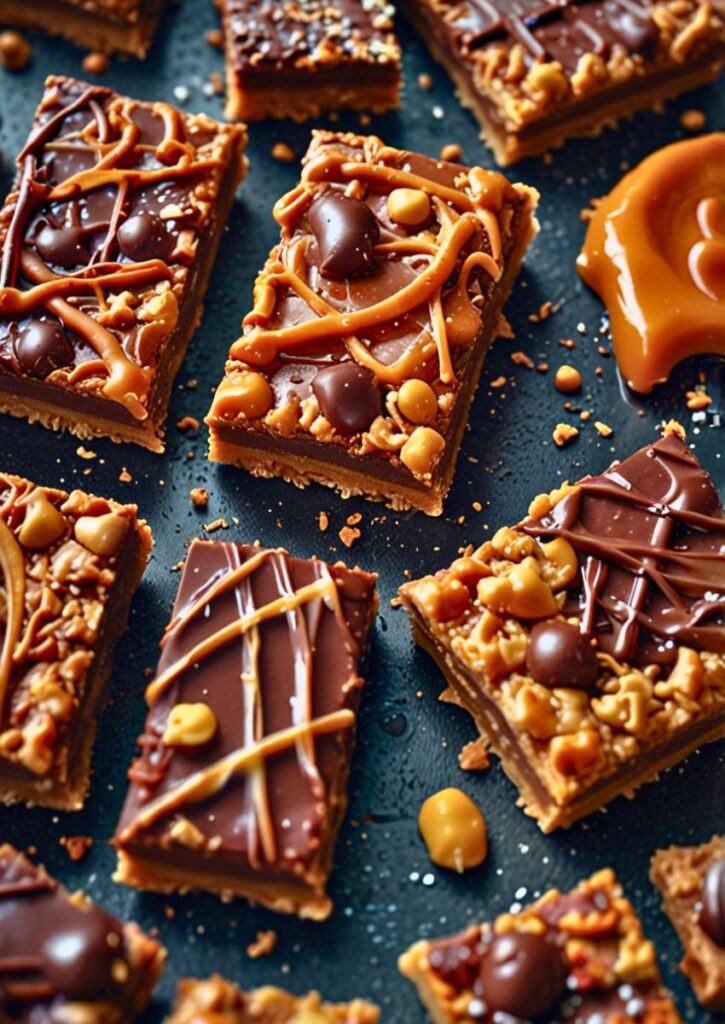
Building the Shortbread Base
Heat your oven to 350°F (175°C). Line a 9×13 inch pan with parchment paper. Leave overhang for easy removal, this separates pros from amateurs.
Combine flour, powdered sugar, and salt in a food processor. Pulse three times to mix evenly. Add cold butter cubes and pulse until mixture looks like coarse meal. Keep some larger butter pieces visible. These create the tender, flaky texture that makes shortbread special.
Whisk egg yolk and cream together. Add to flour mixture and pulse just until dough clumps together. Don’t overwork, you’ll develop gluten and make tough shortbread.
Press dough evenly into prepared pan using a measuring cup bottom. This ensures uniform thickness and prevents weak spots. Prick surface all over with a fork to stop puffing during baking.
Bake 18-22 minutes until edges turn lightly golden. The center should look set but not browned. Cool completely before adding caramel, rushing creates soggy bars.
Mastering the Caramel Layer
Place sugar in a heavy bottomed saucepan over medium heat. Don’t stir initially, let sugar melt naturally around the edges, then gently swirl pan to encourage even melting. This technique prevents crystallization that can ruin caramel texture.
Continue cooking until sugar reaches deep amber color, think burnt honey, not light tea. The difference between good caramel and extraordinary caramel lies in pushing caramelization to the edge of comfort. You want bitter notes to balance sweetness.
Remove from heat and immediately whisk in butter. It will bubble violently, this is normal. Add warm cream slowly while whisking constantly. The cream temperature is crucial; cold cream can cause seizing and temperature shock.
Stir in vanilla and salt. Let caramel cool for 5 minutes, then fold in chopped pretzels. The slight cooling prevents pretzels from completely dissolving while ensuring they adhere properly.
Pour caramel over cooled shortbread, spreading evenly with an offset spatula. Work quickly, caramel firms as it cools. Let set at room temperature for 30 minutes.
Finishing with Ganache
Heat cream in a small saucepan until barely simmering, bubbles should just begin forming around edges. Pour over chopped chocolate in a heatproof bowl. Let sit 2 minutes without stirring.
Start whisking from center outward in small circles, gradually increasing circle size. This technique creates smooth emulsion without incorporating air bubbles. Add butter and whisk until glossy.
Pour ganache over caramel layer, tilting pan to ensure even coverage. The ganache should be fluid enough to self level but thick enough to stay put. Immediately sprinkle with flaky sea salt while ganache is still warm, this ensures salt adheres properly.
Cooking Techniques & Science
What makes Salted Chocolate and Caramel Pretzel Bars truly shine is understanding a bit of the science behind them. Over time, I’ve learned that caramel isn’t just melted sugar, it’s about control. Cooking sugar to 320–330°F gives you that perfect chewy texture with rich, nutty notes. I always look for that deep amber color, like burnt honey, it’s bold but balanced.
Ganache, too, taught me patience. Letting hot cream sit over chopped chocolate before whisking creates a silky finish. With Salted Chocolate and Caramel Pretzel Bars, this ganache layer adds the perfect contrast to the crisp pretzels and sweet caramel.
Even sprinkling the flaky salt matters, doing it while the ganache is still warm ensures it sticks and delivers that pop of flavor in every bite.
Mastering these small techniques transformed how I bake. And with Salted Chocolate and Caramel Pretzel Bars, each bite proves that a little precision goes a long way.
Serving & Pairing Suggestions
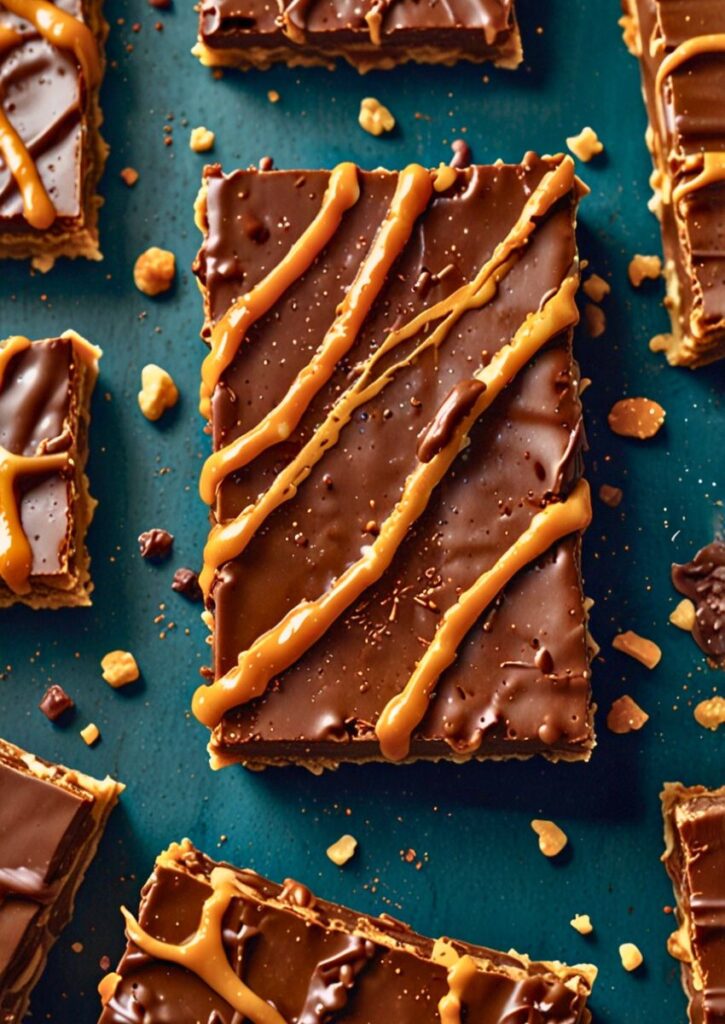
Cut bars with a sharp knife warmed in hot water, wiping clean between cuts. This technique ensures clean edges without dragging chocolate or caramel. For professional presentation, trim edges before cutting to create perfectly uniform pieces.
These bars shine alongside espresso or strong coffee, the bitterness enhances chocolate notes while cutting through rich caramel. For wine pairings, consider port or late harvest Riesling. The sweetness won’t compete, while wine acidity provides palate cleansing between bites.
Temperature affects flavor perception dramatically. Serve at room temperature for optimal flavor balance, though slightly chilled bars offer firmer texture that some prefer. Never serve warm, heat makes sweetness overwhelming and masks subtle flavor notes.
For elevated presentation, dust serving plates with cocoa powder or drizzle with additional caramel. Garnish with toasted pretzel pieces or chocolate shavings for textural interest.
Conclusion
Salted Chocolate and Caramel Pretzel Bars represent everything compelling about modern pastry, familiar flavors elevated through technique and understanding. These bars teach fundamental skills while creating something undeniably delicious.
The beauty lies in precision without complexity. Each component showcases classic techniques, yet the assembly remains straightforward enough for confident home bakers. Master these bars, and you’ll understand flavor balance, texture contrast, and temperature control, skills that transfer to countless other desserts.
Remember that great baking is about patience as much as technique. Let each layer cool properly, taste as you go, and don’t rush the caramelization. The difference between good and extraordinary often comes down to those extra few minutes of cooking time.
These bars improve with time, flavors meld and develop complexity over 24 hours. Store covered at room temperature for up to a week, though they rarely last that long once people discover them.
Frequently Asked Questions.
Can I make these bars ahead of time?
Yes, these bars actually improve after 24 hours as flavors meld together. Store covered at room temperature for up to one week. For longer storage, freeze for up to three months, thaw at room temperature before serving.
Why did my caramel seize up and become grainy?
Caramel crystallization usually results from stirring too early or temperature shock from cold cream. Always let sugar melt naturally before stirring, and warm your cream before adding to hot caramel. If crystallization occurs, add a tablespoon of water and reheat gently.
Can I substitute the pretzels with other ingredients?
Absolutely! Crushed graham crackers, toasted nuts, or even potato chips work beautifully. The key is maintaining the salty crunch that provides textural contrast. Adjust salt in the caramel accordingly based on your substitution’s sodium content.
How do I know when my caramel is the right color?
Look for deep amber, like burnt honey or copper pennies. The caramel should smell nutty and complex, not just sweet. If you have a thermometer, aim for 320-330°F. Too light means missed flavor development; too dark risks bitterness overpowering other elements.
What’s the best way to clean caramel from pans?
Fill the pan with hot water immediately after use and let it sit. The water dissolves hardened caramel naturally. For stubborn spots, simmer water in the pan for a few minutes. Never use cold water on hot caramel equipment, thermal shock can damage cookware.

Swiftly Captions by Tina Smith — Quick, flavorful food recipes made simple, bringing fresh inspiration to your kitchen every day
